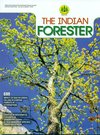Social Forestry in Uttar Pradesh, India- History, Concept, Scheme, Objectives and Role
DOI:
https://doi.org/10.36808/if/2018/v144i8/117343Keywords:
Social Forestry, Components, Schemes, Objectives, Functions, Importance.Abstract
This review paper discusses the history, concepts, scheme and role of social forestry from local and international perspectives. It summarizes the activities of social forestry in the Uttar Pradesh, focusing on the experience and lessons learned from many bilateral and multilateral development projects involved in social forestry in the State. The programmes of most of these projects involve complex institutional development activities, technological improvement, development of infrastructure and other services to attract and retain skilled workers. Joint forest resource management and forest management planning in the state has been reviewed, in spite of the protection measures and patrolling system within natural forest reserves, dependent communities continued to extract their ever-increasing needs from the available natural resources. The paper reviews the social, ecological and economic benefits from social forestry application. The role of different organizations involved in social forestry in the state is highlighted, their involvement ranges from raising local awareness to the encouragement of participation in forest establishment, protection and management.The various varieties of Rosewood, Neem, Cassia, Gulmohar, Jakranda, Cirrus, Kanji, Mango, Chitwan, Banyan, Pipal, Ficus, Mulsri, Bauhinia, Kadamb, Tamarind, Bel and Mahua are being planted in the state as per soil and climatic conditions. The state government is emphasizing on more and more plantation of large and conventional trees.References
Agarwal B. (1997). Environmental action, gender equity, and women's participation. Development and Change, 28(1): 1–44.
Anon. (1987). Microplanning. A tool for social forestry implementation. Publication of National Wastelands Development Board, Ministry of Environment and Forests, G.O.I., New Delhi: 36 p.
Baston G.A. (2002). Empire Forestry and the origins of Environmentalism. Cambridge University Press, U.K.
Baynes J., Herbohn J., Smith C., Fisher R. and Bray D. (2015). Key factors which influence the success of community forestry in developing countries. Global Environmental Change, 35: 226–238.
Bruch W.R. (1987). Gods of the forest: myth, ritual and television in community forestry. Proc. Seminar on Regional Community Forestry Training Center for Asia Pacific SE. Consortium for International Development in collaboration with Agriwiss: 45-58.
Curtin C.G. and Parker J.P. (2014). Foundations of resilience thinking. Conservation Biology, 28(4): 912-923.
Dwivedi A.P. (1992).Principles and Practices of Indian Silviculture. Surya publication, Dehradun.
F.A.O. (1978). Forestry for local community development. FAO Forestry Paper No. 7. Rome.
Gregersen H., Draper S. and Elz D. (1989). People and trees. The role of social forestry in sustainable development. World Bank, Washington D.C.: 273 p.
Gulera A.S. (1990).Production consumption and trade of forest production in India. International Book Distributions, Dehradun.
Hymen E.L. (1985). Monitoring and Evaluation of Forestry projects for Local community development. Agricultural Administration, 19(3): l39-161.
IBRD (1985). Staff and appraisal report. National Social Forestry Project. India.
Jambulingam R. and Fernandes E.C.M. (1986). Multipurpose trees and shrubs on farmlands in Tarnil Nadu state (India). Agroforestry Systems, 4(1): 17-32.
Negi S.S. (1996). Forest for Socio-economic and Rural Development in India. Indus Publications, New Delhi.
Negi S.S. (1986). A Handbook of Social Forestry. International Book Distributor, Dehradun, India.
Singh S.P. (1990). Forestry land evaluation. Surya Publication, Dehra Dun.
Downloads
Downloads
Published
How to Cite
Issue
Section
License
Unless otherwise stated, copyright or similar rights in all materials presented on the site, including graphical images, are owned by Indian Forester.





